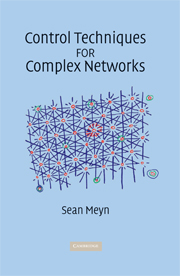Book contents
7 - Demand
from Part II - Workload
Published online by Cambridge University Press: 17 March 2011
Summary
This chapter develops extensions of the fluid and stochastic network models to capture a wider range of activities. As in the previous chapters we allow scheduling and routing. In the demand-driven models considered in this chapter we also permit “admission control” of raw material arriving to the network so that the total amount of material in the system can be regulated. Although manufacturing systems will motivate most of the discussion in this chapter, power distribution systems as described in Section 2.7 and some communication systems can be modeled as demand-driven networks.
Figure 7.1 illustrates a typical example of the class of models to be investigated. In this 16-buffer network there are two sources of exogenous demand, and the release of two different types of raw material into the system is controlled. At two of the five stations there are multiple buffers so that scheduling is required, and routing is controlled at the exit of Station 3.
This is the most complex example considered in any detail in this book, although it is far simpler than a typical semiconductor wafer fab as described in Section 1.1.1. The International Semiconductor Roadmap for Semiconductors (ITRS) provides an annual assessment of the challenges facing the semiconductor industry [279]. In recent years their reports have contained some recurring themes:
Contention for resources There may be dozens of different product flows in a single factory.
- Type
- Chapter
- Information
- Control Techniques for Complex Networks , pp. 246 - 294Publisher: Cambridge University PressPrint publication year: 2007

